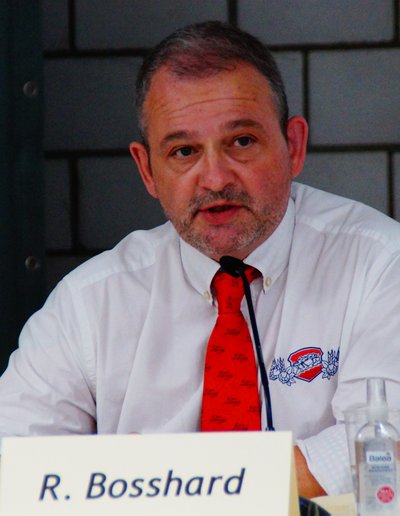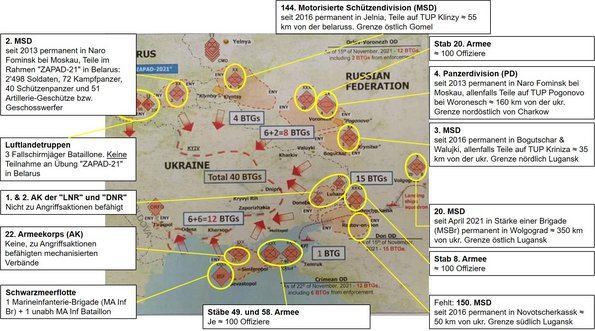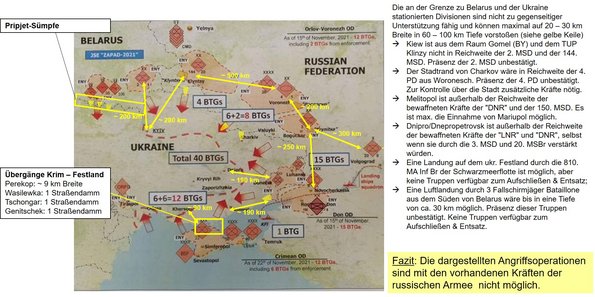Russian troop deployment – reality or US political bubble?
by Ralph Bosshard*
Officially, little has leaked out about the content of the video conference between US President Biden and his Russian counterpart Vladimir Putin. Both sides released a rather meagre statement about it. What is clear is that, despite the hype in the Western press, other trouble spots besides Ukraine played a role. Vladimir Putin achieved an important goal: the USA was forced to talk to Russia at eye level. And Joe Biden used the opportunity to present himself as a democratic hardliner after the debacle in Kabul last August.1
As late as mid-November, Ukrainian officials had denied that Russian troops were deployed in the border area.2 At the time, the spokespersons for the president, the National Security Council and the Ukrainian chief of staff all expressed this view. On the contrary: It was said at the time that the reports of concentrations of Russian troops on the border were part of psychological warfare against Ukraine – whatever one may think of that.3
The majority of Russian troops on the Ukrainian border are those that have been permanently stationed in western Russia for years. An analysis of the terrain and capabilities of the troops involved shows that they are not capable of the offensive operations described by the West.
Background
In 2013, the Russian army re-established two divisions in Naro-Fominsk, west of Moscow, that had been disbanded in the wake of former Defence Minister Anatoly Serdyukov’s reforms: the 2nd Motorised Rifle Division and the 4th Armoured Division.4 In 2016, the 3rd, 144th and 150th Motorised Rifle Divisions followed. All of these divisions are not actually new formations, but rather the consolidation of existing troops from other regions of Russia. The basis for this decision was the realisation that the “brigadisation” of the Russian army in the course of Serdyukov’s reforms had been a mistake. While the downsizing of the Russian divisions and their transformation into brigades may well have worked well in mountainous regions such as the Caucasus, for example, the elimination of a hierarchical level in the Russian military districts led to an unnecessarily high number of directly subordinated large units and made leadership more difficult.
The 144th Motorised Rifle Division has been stationed in Yelnya, about 80 km southwest of Smolensk, since its formation. The town is connected to the railway line to Smolensk and from there on to Minsk. From Smolensk, the Belarusian cities of Orsha and Vitebsk are about 100 and 120 km away respectively.
These two cities gained great importance in the recent history of war. In the operational study for a campaign against the Soviet Union, which was later named after him, the then Colonel of the General Staff Bernhard von Lossberg concluded in 1940 that it would be difficult for the German Wehrmacht to quickly defeat the Red Army crucially if the latter were to retreat behind a line Daugava-Dnieper.5 Orsha and Vitebsk delimit an approximately 80 km wide gap between the upper reaches of these rivers. The rivers in eastern Belarus, regardless of water depth and flow velocity, can only be crossed away from existing bridges after extensive pioneering work. They are often lined by extensive forest or swamp areas, which necessitates the construction of access roads and solid abutments. Vitebsk and Orsha were also the first targets of Operation “Bagration”, which began on 22 June 1944 and resulted in one of the Red Army’s greatest successes in World War II. It led to the complete collapse of the German Army Group Center (Heeresgruppe Mitte) and is still considered the greatest defeat in German military history.6
In order not to become a frontline state in a new Cold War, the Republic of Belarus has so far rejected the permanent stationing of Russian troops on its territory. There are only two military facilities of the Russian armed forces in Belarus: the radar station of Hantsavichy and the long-wave transmitter Vileyka.7 The former is used for early detection of ballistic missiles approaching from the west and the latter for communication with submerged submarines. The transfer of reinforcements from Russia is of crucial importance for the military security of the Republic of Belarus in view of the numerical superiority of NATO troops in Poland and the Baltic States. Within the framework of the exercises “Zapad-17” and “Zapad-21”, however, massively fewer Russian troops were transferred to Belarus than had been planned in the event of war. According to Belarusian information, no Russian troops remained in Belarus after the conclusion of exercise “Zapad-21”.8
What has been said about the Daugava and Dnieper also applies to the Pripyat in the border area between Belarus and Ukraine. The Pripyat marshes had already been recognised by Lossberg as an obstacle that does not allow a push of armoured units in a north-south direction. Even today, Ukraine is hardly threatened by an incursion of large armoured units, at least from this direction.
The 3rd and 150th Motorised Rifle Divisions are stationed closer to the Ukrainian border. The former is in Boguchar, south of Voronezh, and the latter in Novocherkassk near Rostov-on-Don. Of the newly formed 20th Motorised Rifle Division, one brigade exists so far near Volgograd, 350 km from the Ukrainian border. Together with other support troops, the Russian formations mentioned above may well amount to a personnel strength of 75,000 to 100,000 men. In view of the fact that they are spread along a border of about 1500 km, there can be no question of a massive deployment. And one very important piece of information that would allow us to make a final assessment of the Russian force deployment is completely missing from the US and Ukrainian documents: the locations of the support units of the missile troops, the artillery, the engineer troops, the NBC defence and generally of the air defence and airborne troops.
Few sources
The most important bases for the current hype are maps of the Ukrainian intelligence service and satellite images that US think tanks and journalists have obtained from commercial providers since mid-November.9 They always show the same troops on the well-known military training grounds of Pogonovo near Voronezh and Yelnya near Smolensk.
If one can trust the published footage, then the 144th Motorised Rifle Division, in particular, is still at its peacetime location and has neatly positioned its large equipment. If an invasion of Ukraine were planned, the large equipment would probably have been decentralised and carefully camouflaged in the numerous forests of the Smolensk region. As currently deployed, the Russian troops of the 144th MSD represent an ideal target for air strikes.
The Pogonovo military training ground has also been the scene of exercise activities by the Russian army in recent weeks, namely the 3rd Motorised Rifle Division. Compared to Boguchar, Pogonovo is further away from the Ukrainian border (about 150 km). Therefore, there is no question of moving troops closer to the border. Furthermore, it would be interesting to see satellite pictures from Naro-Fominsk, where two of the divisions are stationed that are supposedly involved in the alleged troop deployment.
The suspicion expressed by some media that the ongoing information campaign serves to prepare a Ukrainian offensive in the Donbas has so far not proven true: the situation on the contact line in eastern Ukraine is currently comparatively calm, as the daily reports of the OSCE Special Monitoring Mission show.10
Froth from Washington
There is no reason to see why the threat situation in Ukraine should have changed in comparison to the past. The designated Russian formations are not capable of the described offensive operations and cannot support each other. A Russian invasion of Ukraine thus remains unlikely. If the Russian army had really been planning an invasion of Ukraine since mid-November, Joe Biden’s reaction would be far too late anyway, because Russian general staff officers are used to preparing defence and counter-attack operations within 10 to 14 days. The question therefore arises why the deployment of Russian units is being discussed now of all times.
With his threats to his counterpart Vladimir Putin, US President Joe Biden probably kicked an open door and prevented a Russian invasion, which was hardly planned at the present time. He was thus able to polish up his image, which had suffered some scratches after the debacle in Kabul in August. The paratrooper battalion that the British government wanted to send to assist the Ukrainian army can stay at home. That this will not be able to stop a Russian armoured division is also known in Kiev. With his pithy appearance and his threats, Biden has puffed himself up just before his democracy summit.11 The Russian ambassador summed up Russia’s attitude at the meeting of the OSCE Forum for Security Co-operation on 8 December in Vienna with an extremely undiplomatic remark: We now want to talk to the overlords, not to their vassals.
The buzz in the press about the Russian troops in the border area with Ukraine shows how propagandists on both sides take advantage of the inability of large sections of the media to critically examine the information they receive in order to spread dubious narratives. Western public opinion has traditionally been critical of information from Russian sources. Recent events show that they should also adopt this attitude with regard to information from Western capitals. •
1 White House statement online at https://www.whitehouse.gov/briefing-room/statements-releases/2021/12/07/readout-of-president-bidens-video-call-with-president-vladimir-putin-of-russia/, the official Kremlin announcement, online at http://en.kremlin.ru/events/president/news/67315. Instructions for Russian diplomats: https://tass.com/politics/1372995
2 Satellite images had already been presented at the time: cf. Christiaan Triebert on Twitter https://twitter.com/trbrtc/status/1455294700605300742 and Dara Massicot of the RAND Corporation https://twitter.com/massdara/status/1462254401624711172?s=21. The Ukrainian government’s comment on this at Illia Ponomarenko. Russia’s major invasion of Ukraine not imminent, experts say, in: Kyiv Post of 3 November 2021, online at https://www.kyivpost.com/ukraine-politics/russias-larger-invasion-in-ukraine-currently-unlikely-experts-say.html.. Cf. Ukrinform: No imminent threat of massive offensive by Russia – NSDC Secretary, online at https://www.ukrinform.net/rubric-polytics/3357781-no-imminent-threat-of-massive-offensive-by-russia-nsdc-secretary.html
3 see Volodymyr Havrylov. “The Russian military build-up around Ukraine: Routine, seasonal manoeuvres”, in: 112UA of 11 November 2021, online at https://112.international/politics/the-russian-military-buildup-around-ukraine-routine-seasonal-maneuvers-66750.html and TNG news: “Zelensky’s office confirms no information about Russian troops on Ukraine’s borders”, in: TNG News of 7 November 2021, online at https://thenewsglory.com/zelenskys-office-did-not-confirm-data-on-russian-troops-near-ukraines-borders/
4 Serdykov was in office from 2007–2012. See the official homepage of the Russian Ministry of Defence: https://function.mil.ru/news_page/country/more.htm?id=11735703@egNews
5 see Walter Warlimont. Im Hauptquartier der deutschen Wehrmacht. Augsburg 1990, vol. 1, p. 150 f. Cf. also Ernst Klink: “Die militärische Konzeption des Krieges gegen die Sowjetunion”. In: MGFA (ed.): Das Deutsche Reich und der Zweite Weltkrieg. Stuttgart 1983, Vol. 4, p. 230, and Percy Ernst Schramm (ed.): Kriegstagebuch des Oberkommandos der Wehrmacht. Bonn o. J., Vol. 1, 1st half-volume, p. 82
6 One overview among many of “Operation Bagration” is given by Gernot Kramper. “Operation Bagration – diese Offensive zerbrach das Rückgrat der deutschen Wehrmacht”, in: Stern online at https://www.stern.de/digital/technik/operation-bagration---diese-offensive-brachte-das-ende-der-wehrmacht-8769666.html. For the scholarly review see: Das Deutsche Reich und der Zweite Weltkrieg, vol. 8: Die Ostfront 1943/44. Der Krieg im Osten und an den Nebenfronten. With contributions by Karl-Heinz Frieser, Klaus Schmieder, Klaus Schönherr [and others], edited by Karl-Heinz Frieser on behalf of the Military Historical Research Office, Munich 2007.
7 on Vileyka see https://englishrussia.com/2007/08/07/above-woods-of-belarus/#more-1207, on Hantsavichy https://www.globalsecurity.org/wmd/world/russia/volga-70m6.htm
8 On the Zapad-21 exercise, see the official information from the Belarusian Ministry of Defence at https://www.mil.by/ru/news/137264/ and from the Russian Ministry of Defence at https://function.mil.ru/news_page/country/more.htm?id=12378427@egNews (both in Russian). Cf. https://cepa.org/russias-zapad-21-lessons-learned/. According to information from the the Belarusian Ministry of Defence, Russian troops of the 1st Armoured Army numbering 2,498 soldiers were in Belarus, with 72 battle tanks, 40 infantry fighting vehicles and 51 artillery guns or projectile launchers (MLRS).
9 These include those obtained from “Maxar” by the US journalist Mike Eckel, who works for Radio Free Europe. See https://twitter.com/mike_eckel/status/1467585097482358786?s=21. For Mike Eckel, see https://www.rferl.org/author/mike-eckel/muvyqo. “Maxar” was formed after the merger of Space Systems/Loral and DigitalGlobe in 2017. DigitalGlobe supplied Google Maps with satellite images, among others. See https://www.maxar.com/about and https://www.geospatialworld.net/news/mda-dg-combined-entity-to-be-rebranded-as-maxar-technologies/
10 See Ekaterina Blinova. “Why Washington’s ‘Russian Invasion’ Scare is Cover for Kiev’s New Offensive Against Donbas”, in Sputnik of 27 November 2021, online at https://sputniknews.com/20211127/why-washingtons-russian-invasion-scare-is-cover-for-kievs-new-offensive-against-donbass-1091072603.html and “Donetsk News Agency: Pushilin tells Slutskiy that situation in Donbass escalates”, in: DAN, Donetsk News Agency of 6 December 2021, online at https://dan-news.info/en/politics/pushilin-tells-slutskiy-that-situation-in-donbass-escalates/. The SMM reports are published daily on the OSCE homepage: https://www.osce.org/ukraine-smm/reports
11 cf. Moritz Koch, Jens Münchrath, Torsten Riecke. “Biden lädt zum Demokratie-Gipfel ein – und spaltet damit die Welt” (Biden invites to democracy summit – and divides the world with it), in: Handelsblatt of 9 December 2021, online at https://www.handelsblatt.com/politik/international/gipfeltreffen-biden-laedt-zum-demokratie-gipfel-ein-und-spaltet-damit-die-welt/27874244.html?ticket=ST-6011251-Uc3Jgy3YaCSGq3IMoWg1-cas01.example.org
* Ralph Bosshard studied General History, Eastern European History and Military History, completed the Military Command School of the ETH Zurich and the General Staff Training of the Swiss Army. This was followed by language training in Russian at the Moscow State University and training at the Military Academy of the General Staff of the Russian Army. He is familiar with the situation in the South Caucasus from his six years at the OSCE, where he was, among other things, Special Advisor to the Swiss Permanent Representative.


